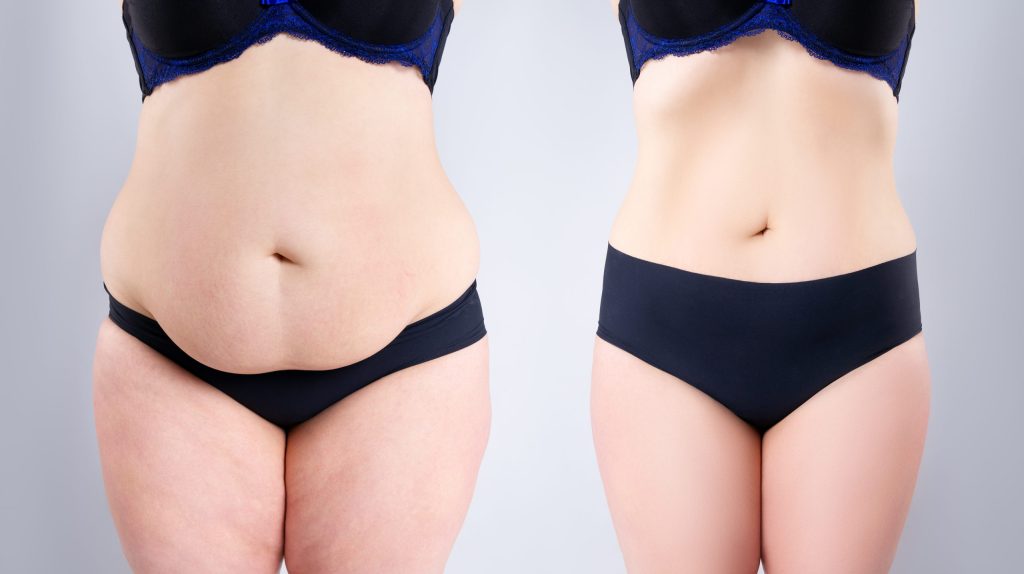Obesity is a global issue faced by many people. There are some who are able to lose a lot of weight by persistent diet and exercise while some who opt for bariatric surgery to help lose the extra pounds.
However, with major weight loss comes excess hanging skin folds and an unshapely body. This is why you may require body contouring procedures to make you look and feel your best.
What is bariatric surgery?
Bariatric surgery involves making changes to your digestive system to help you lose weight. It is considered as an option when diet and exercise have not worked or when the patient has serious health problems due to the excess weight. Procedures include those that limit how much you can eat, procedures that reduce the body’s ability to absorb the food you eat and combinations of both. While bariatric surgery offers several benefits, long-term success also requires permanent healthy changes to your lifestyle.
What are body contouring procedures?
Body contouring is a type of surgery that improves the shape and contour of your body by removing excess skin and fat tissue. Body contouring surgeries are performed by Plastic Surgeons after the patient has achieved stable weight and has maintained that weight for a minimum period of six months. When someone gains a lot of weight his or her skin slowly stretches over time. After weight loss the stretched skin looses its elasticity and may not revert to normal leading to rolls and folds of excess skin and tissue around the belly, thighs, arms, back, face, chest and breasts.
Depending on the problem areas, there are a variety of body contouring procedures that are recommend to help improve the tone and shape of your body. These procedures are usually done in stages depending upon your requirements.
Post weight loss motivated patients who have adapted their lifestyle to healthy restricted diet along with regular exercise and have a realistic expectation are good candidates for Body Contouring Surgeries.
Why do I need body contouring surgery?
The excess skin and tissue after bariatric surgery may be a constant reminder of the extra weight you used to carry around. You might have loose and saggy looking upper arms, flattened breasts with nipples pointing down, an apron-like overhang skin around the abdominal area or sagging buttocks and thighs.
Other than aesthetics and poor self-esteem, excess skin tissue may also cause discomfort, swelling, rashes or infection in between skin folds, trouble walking or urinating, interfere with sexual activity and more.
What are the various types of Body Contouring Surgeries?

Here are examples of a few common Body Contouring procedures you may be recommended:
Arm Lift (Brachioplasty) – This is performed to remove skin and fat from the arms. An incision is made on the underside of the arm and excess skin and tissue is removed. The length of the incision or cut may depend on the amount of excess tissue present and usually extends from the armpit to the elbow or may have an extension to the side of the chest. Incisions/ Cuts are planned on less visible areas of the body. Liposuction may also be a part of the procedure.
Breast Lift (Mastopexy) – This procedure helps to lift drooping breasts into a fuller and more upright youthful position. While the surgeon removes excess skin and tissue from around the breasts, breast implants may or may not be required to make up for volume loss within the deflated breasts.
Tummy Tuck (Abdominoplasty) or Belt Lipectomy – Loose folds of skin hanging over the abdominal area is usually what most bothers patients who have undergone tremendous weight loss. These folds may even extend circumferentially involving the sides as well as back. Even the buttocks may become loose and sag due to the volume loss in that area. A variety of procedures may be performed here depending on the problem areas. A panniculectomy procedure removes basic excess skin but more might be needed for those suffering from significantly elastic skin hangover. A belt lipectomy (circumferential lipectomy) targets the waist, back and flank problem areas where the incision goes all the way around the patient’s midsection including the front and back. The belt lipectomy helps to improve and tone the abdomen, flanks, buttocks as well as the outer side of the thighs. Liposuction is usually required here to achieve uniform contour.
Thigh Lift – There can be excess skin on the inner as well as the outer portion of your thighs. The outer portion of the thighs usually gets corrected with a belt lipectomy. For the inner thighs, the surgeon makes an incision or cut from the groin to the knee, removes the excess tissue and re drapes the skin to give a firm look to the thigh. The extent of tissue removal and the length of the incision all varies depending on individual requirements.
Your surgeon may recommend one or more of such procedures to help with your overall body shape and contour.
What risks are involved when undergoing body contouring surgery?
As with any surgery, there are risks involved with body contouring procedures and the risks also depend on the patient’s overall health and wellbeing. It is important to discuss your medical problems, the medications you are on, your addictions if any with your Plastic Surgeon. Patients undergo a detailed assessment, pre-operative investigations, anesthetist’s evaluation and are then optimized to undergo the surgery. The risks are minimal with an optimized patient, good operating facility along with standard intra operative and post-operative measures. Staging of surgeries and customized post-operative instructions are formulated for safer outcomes and recovery.
How long does it take to get back to normal after body contouring surgery?
Recovery from surgery takes a week or two depending upon the procedure. The staging of procedures helps in getting back to normal routine faster than trying to correct many areas in one surgery.
Body contouring procedures typically require a week’s rest at home, gym activity only at six weeks after surgery and at least three months for the cosmetic result to be apparent. Scars require longer (at least 12 months) to fade with the help of scar reducing protocols suggested by your surgeon. Be sure to consult your surgeon before going back to normal routines as the healing process is crucial for longer lasting results.
How long do the Body Contouring results last?
It is important for patients to maintain stable weight prior to surgery as well as after to avoid problems such as contour deformities. Consistently healthy lifestyle changes are required for longer lasting results. Weight fluctuations can cause issues with scars and skin elasticity hence the patient must be committed to the cause.
Every patient is on a different journey and their surgical options will be different based on their specialized case.
Dr. Amiti can guide you through your journey of decision making, preparation, surgery and a safe recovery. Schedule a consultation and take the last steps towards the shape and confidence you always desired

